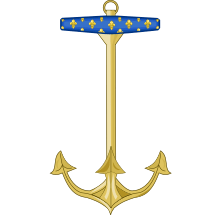Great Officers of the Crown of France
The Great Officers of the Crown of France (French: Grands officiers de la couronne de France) were the most important officers of state in the French royal court during the Ancien Régime and Bourbon Restoration. They were appointed by the King of France, with all but the Keeper of the Seals being appointments for life. These positions were not transmissible nor hereditary.

During the time of the First French Empire, the equivalent officers were known as the Grand Dignitaries of the French Empire. The Great Officers of the Crown of France should not be confused with the similarly named Great Officers of the Royal Household of France (French: Grands officiers de la maison du roi de France), which share certain officers, headed by the Grand Master of France.
History
In 1224, Louis VIII legislated that the Great Officers participate, alongside the peers of France, in trials of members of the peers.
The military titles, such as Marshal of France, Grand Master of Artillery, and Colonel General, were offices granted to individuals and not military ranks.
Great Officers of the Crown
In the hierarchical order established by Henry III in 1582, the Great Officers of the Crown of France were:
- Constable of France (French: Connétable de France), the First Officer of the Crown and highest commander of the French army, until the position was suppressed in 1626.
- Lord Chancellor of France (French: Chancelier), ran the judicial system. The chancellor was assisted in his tasks by the Keeper of the Seals.
- Grand Master of France (French: Grand maître de France), similar to the title of High Steward, was head of the King's Household.
- Grand Chamberlain of France (French: Grand chambellan de France), in charge of the king's chamber, with additional duties.
- Admiral of France (French: Amiral de France), highest commander of the French Navy.
- Marshal of France (French: Maréchal de France) was a dignity bestowed only on to generals for exceptional achievements. The office alternated between being junior to and then senior to the Constable of France; after the suppression of the Constable, the Marshal of France became the de facto head of the army. The title Marshal General of the Camps and Armies of the King (French: Maréchal général des camps et armées du roi), more commonly referred to as the Marshal General of France, was created superior to the Marshal of France to signify that the recipient had authority over all the French armies in the days when a Marshal of France governed only one army. This greater dignity was bestowed only on Marshals of France, usually when the dignity of Constable of France was unavailable or, after 1626, suppressed.
- Grand Squire of France (French: Grand écuyer de France), similar to the title Master of the Horse, in charge of the king's stables.
- Grand Master of Artillery (French: Grand maître de l'artillerie) was created a Great Office in 1601 by Henry IV, but later suppressed by Louis XV in 1755.
In the 17th and 18th centuries, the Secretaries of State were also included with the Great Offices:
- Secretary of State for Foreign Affairs
- Secretary of State for War
- Secretary of State of the Navy
- Secretary of State of the Maison du Roi, who also oversaw the clergy, and the affairs of Paris.
- Secretary of State for Protestant Affairs
Other officers
In addition to the aforementioned Great Officers of the Crown there were several positions of importance that have been considered de facto Great Officers by scholars, and other offices that were created to carry out specific functions of the Great Officers whose list of responsibilities became too cumbersome to perform alone and those offices that acted as direct subordinates to the Great Officers.
- Keeper of the Seals (French: Garde des Sceaux), assistant to the Chancellor.
- Grand Almoner of France (French: Grand aumônier de France) was charged with keeping the royal chapel.
- Colonel Generals were officers ranking immediately below the Marshals of France. The first office was created by Francis I, and by the end of the Ancien Régime included the offices of Colonel General of the Infantry, Colonel General of the Cavalry, Colonel General of the Dragoons, Colonel General of the Hussards, Colonel General of the Cent-Suisses & Grisons and Colonel General of the Gardes Françaises.
- Lieutenant-General of the Realm, a governor and military representative of the king, who oversees all royal business in a province and reports directly to the king.
- Grand Master of Ceremonies
The 17th century genealogist Père Anselme also included the following as Great Officers:
- Porte Oriflamme, standard-bearer of the Oriflamme (Royal Standard) in battle.

- General of the Galleys ("Général des Galères"), military position in charge of the galleys.
- Grand Veneur of France, the master of the hunt and royal Game Warden.
- Grand Falconer of France (Grand Fauconnier), master of the falcon hunt and hunting lodges.
- Grand Louvetier of France, master of the wolf hunt
- Grand Échanson, the royal cup-bearer.
- Grand Maitre des Eaux et des Forêts, in charge of rivers and forests.
The following offices from the Medieval court are generally considered a posteriori Great Offices, even though the expression, as such, did not exist at the time:
- Grand Seneschal of France, head of the king's armies and of the royal household, position suppressed in 1191.
- Grand Chamberman of France, head of the King's chamber, position suppressed in 1545.
- Grand Bouteiller, master of ceremonies, judgements of nobility, royal table and wine cellars.
- Grand Master Crossbowman (Grand maître des arbalétriers) - position subsumed by the Grand Master of Artillery.
- Grand Panetier of France, 'bread master', also supervises the city bakeries.
- Grand Queux, the royal cook.
See also
- Grand Dignitaries of the French Empire
- Great Officer of State